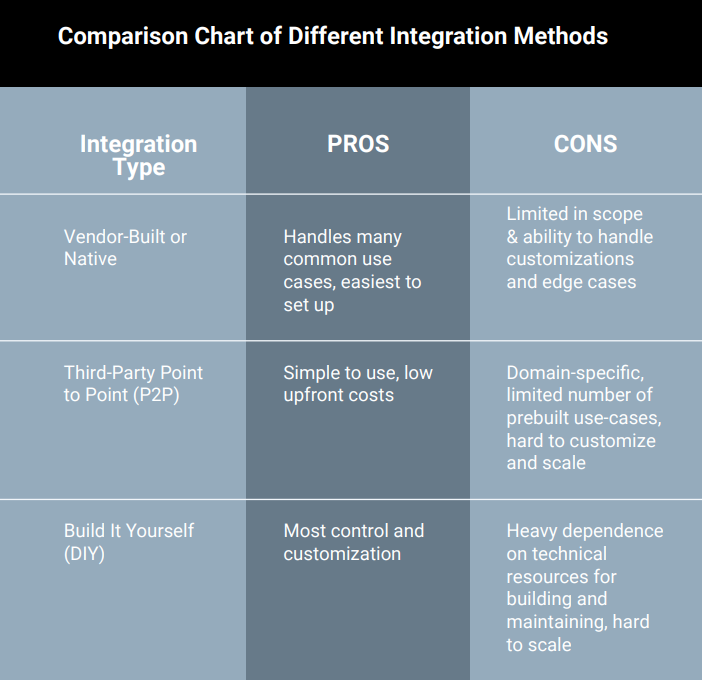
Section 3: How Organizations Tackle Integration
Although the concept of integrating applications has existed for years, most organizations still treat it as an afterthought when new applications are added. From there, integration projects are tackled on an as-needed basis. When they ultimately do move forward, organizations often use a patchwork of solutions to try and integrate their applications.
Vendor-Built or Native Integrations
Most software includes out-of-the-box native integrations, allowing users to quickly connect with specific applications. For example, practically every marketing automation tool today connects directly to Salesforce. This is very convenient, often covers the most popular use cases, and usually don’t incur additional subscription costs. However, the challenge with native integrations is that they are designed to sell and renew the vendor’s offering and typically only cover the use cases that will check the box in the sales cycle. This means they are typically static, not designed with enough flexibility or customization capabilities to address important edge cases.
Third-Party Point-to-Point (P2P) Connectors
Just like vendor-built integrations, point-to-point connectors seem very convenient and cost-effective upfront. However, they are typically domain-specific, and not designed to accommodate larger business processes. Also, with thousands of cloud apps available today, it’s difficult to develop individual point-to-point connectors to cover every possible permutation of business applications.
Build It Yourself (DIY) Integrations
Leveraging code and APIs to build custom integrations can be very powerful and are often the preferred path taken by many operational teams. However, because they require trained technical personnel and are very time consuming to build, this solution is difficult to scale. Furthermore, as processes change, these application integrations need to be continually maintained and updated. For these reasons, DIY integrations are not practical for organizations with lean technical resources.
Different Integration Methods
The lack of uniformity between these methods, along with the fact that there is no perfect solution for each use-case, means that it can be difficult for organizations to find solutions that fit their integration needs. However, standardizing integration can solve for all of these needs while boosting the efficiency of your systems. The best strategy to achieve this goal involves the adoption of integration Platform as a Service, or iPaaS.
Section 4: Standardizing Integrations with iPaaS
The term “iPaaS” was coined by advisory firm Gartner in reference to a cloud-based integration platform that makes connecting applications and business processes much easier. Integration Platform as a Service solutions holistically standardize how applications are added to an organization, making it easier to move static or transactional data across applications while providing critical integration functionality out-of-the-box.
Leveraging an integration platform makes sense for growing companies since it standardizes how to monitor, maintain, and update processes across applications, which are added and changed every day. Organizations can quickly integrate applications into their business processes, without having to reinvent the wheel when it comes to building integration functionality. With the right iPaaS, both line-of-business users (“citizen integrators”) and technical users (“integration professionals”) can build, manage, and maintain integrations.
Although the term iPaaS is relatively unknown, integration Platform as a Service is the fastest-growing segment in the enterprise market space according to Gartner.
Common Features of iPaaS Solutions
Functionalities of integration Platform as a Service solutions typically include:
- Guaranteed data delivery: The ability to hold data until it has safely reached its destination
- Error handling: The ability to indicate where errors occur in the transfer of data
- Endpoint connectors: iPaaS solutions typically make it easier to connect with specific applications without needing to code directly via API; this includes connectors for specific applications, as well as for universal communication protocols, such as FTP/SFTP; HTTP/S, OFTP, OFTP2; XML standards; as well as EDI, EDIFACT, SWIFT, and many others
- Data governance: Enables only users who are granted specific permission to access data
- Lifecycle management: A centralized console for use in creating, managing, and governing integrations; develop integration flows that automate the exchange of data between disparate applications, siloed data sources, and trading partners
- Developer tools: Developer tools enabling deep customization and complexity when building integration flows
Contact Us for more information on iPaaS with Celigo for your Business.
Copyright © 2024 - Custom Software Solutions, Inc.







